 Our guest blogger, Dr. Laurie Naranch, is Associate Professor of Political Science at Siena College, where she specializes in Modern and Contemporary Political Theory, Feminist Political Theory, Women, Gender, Sexuality and Politics, Human Rights, Film and Politics, Culture, Memory, and Politics, and The Politics of Clothing. She is alsoDirector of Women’s, Gender, and Sexuality Studies. Laurie has co-led several student trips to the Guatemalan highlands in conjunction with Mayan Hands to study the impact of fair trade on Mayan communities. In this blog post, she reviews Deborah Chandler's latest book, A Textile Traveler's Guide to Guatemala.
Our guest blogger, Dr. Laurie Naranch, is Associate Professor of Political Science at Siena College, where she specializes in Modern and Contemporary Political Theory, Feminist Political Theory, Women, Gender, Sexuality and Politics, Human Rights, Film and Politics, Culture, Memory, and Politics, and The Politics of Clothing. She is alsoDirector of Women’s, Gender, and Sexuality Studies. Laurie has co-led several student trips to the Guatemalan highlands in conjunction with Mayan Hands to study the impact of fair trade on Mayan communities. In this blog post, she reviews Deborah Chandler's latest book, A Textile Traveler's Guide to Guatemala.
A Textile Traveler’s Guide to Guatemala (2019) is a wonderful guide for weaving experts and non-experts alike. Written in a thoughtful and accessible way by weaving expert Deborah Chandler, this is an important book for developing cultural knowledge about Maya communities in Guatemala, understanding how to access diverse locations, and a companion to ethical travel that is cooperative with indigenous communities and excellent nonprofit organizations. The book is also accompanied by beautiful photographs and illustrations making this one of the more pleasurable guidebooks out there for the traveler who wants to know something about a place and a people.

Chandler, who has lived in Guatemala for decades, has succeeded in her goal of writing a book for “textile tourists” to find their way, to “see great riches in cloth, and perhaps even more, to understand what they are seeing when they have those textiles in their own hands.” For guidance in finding your way among the millennia-old Maya culture, Chandler offers practical tips on money to basic language expressions and advice on eating street food along with a suggesting a range of accommodations and restaurants. But the heart of the book is about Maya textiles and the women who make them to wear and to sell.
The book is divided by geographical area starting with Guatemala City ranging to Chimaltenango and communities around Lake Atitlán among others. There are twenty-two Maya language communities in Guatemala and countless markets to visit. Chandler has done a remarkable job curating a rich set of markets and NGOs to visit organized by region in her guidebook. Throughout the guide there are sidebars and inserts offering information about women, specific weavers, and their techniques. As you read the book you will learn about the patterns you will see in the traditional dress or traje(traje tipica or traje tradicional). The end of the book has a very nice, brief dictionary of textile vocabulary in Spanish and different Maya languages as well as a resource guide listing yearly events, suggested readings, and different tour groups offering textile focused tours in particular.
Mayan Hands is one of those nonprofit groups that offers textile focused tours to learn about weaving traditions, women’s empowerment, and current struggles in Guatemala. Chandler mentions Mayan Hands along with other groups in the book, many of whom coordinate with one another for tours. As someone who has travelled to Guatemala several times since 2014 with Mayan Hands and a research group of faculty and students, I found Chandler’s book especially valuable as a guide for further knowledge about weaving, different Maya communities, and as an important guide for ethical purchases.
Textiles are an important and essential human product, as Chandler says. Textiles offer a view into an evolving Maya tradition in Guatemala where women are the ones who continue the practice of weaving. Having a reliable, conscientious guide to how to find, interact with the makers, and purchase some of these beautiful textiles as part of a trip to Guatemala is a wonderful thing to have.









Leave a comment (all fields required)